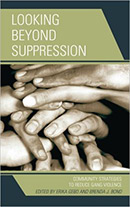Looking Beyond Suppression:
Community Strategies to Reduce Gang Violence
 Authors: Erika Gebo and Brenda J. Bond, eds.
Authors: Erika Gebo and Brenda J. Bond, eds.
Publisher: Lanham, MD: Lexington Books, 2012. 191p.
Reviewer: James C. Howell | January 2013
Named after deceased Massachusetts Senator Charles E. Shannon, Jr., the Shannon Community Safety Initiative (Shannon CSI) was first funded in 2006 by the Massachusetts legislature to implement the Comprehensive Gang Prevention, Intervention, and Suppression Model statewide. To qualify for participation, grantees were required to have a population of at least 100,000, have high levels of youth violence and gang problems, commit to coordinated prevention and intervention strategies, and develop a comprehensive plan to work with multidisciplinary partners. The number of partner agencies varies by site but typically includes faith-based and other local organizations, government agencies, schools, and local police departments. Research partners assist sites with data collection and analysis, identifying best-practice programs to incorporate in site-specific strategies, and in making recommendations to improve partner programs.
The Shannon CSI is a massive statewide initiative across urban areas. Initially, 15 sites were funded, encompassing 37 communities. In the fourth year, funding was expanded to 17 sites, composed of 41 municipalities. In 2013, the Shannon CSI will enter its seventh year of funding, having made awards totaling more than $56 million to date. A complete description of the initiative, along with several useful reports and other resources, can be found at: http://www.mass.gov/eopss/funding-and-training/justice-and-prev/grants/shannon-csi/.
For the benefit of readers who are not familiar with Shannon CSI, I feel compelled to provide a brief overview of the Comprehensive Gang Model (CGM). The CGM aims to reduce gang involvement and gang crime at three levels: communities, gangs, and individuals (see Spergel, Wa, and Sosa, 2006; National Youth Gang Center, 2010; Wyrick, 2006). Before launching the CGM it is necessary to carry out a communitywide assessment of existing gang problems that stakeholders themselves conduct (with external research assistance as needed), which then is used as the basis for a targeted strategic plan. Stated simply, prevention programs are needed to target youth at risk of gang involvement, to reduce the number of youth who join gangs; intervention programs and strategies are needed to provide sanctions and services for younger youth who are actively involved in gangs to separate them from gangs; and law enforcement suppression strategies are needed to target the most violent gangs and older, most criminally active gang members (Wyrick, 2006). The recommended administrative structure for implementing the CGM consists of a steering committee, a lead agency, a project coordinator, a research partner, and a multi-agency intervention team with outreach services.
The uniqueness of this book is that it is written by persons who were actively involved in implementing the CGM in the communities funded by the Shannon CSI. For the first time, researchers (mainly) who had nothing to do with developing the original CGM describe from within sites the process of implementing it. To our good fortune, we find out what it’s like to mobilize communities to do this, the obstacles they encountered and successes in overcoming those. Hence, their experiences are of great importance to others who accept the challenge of implementing the CGM. Complex social problems such as gangs that are rooted in dysfunctional communities in our society defy simple solutions. The committed leaders of this multi-site initiative confirmed the obstacles, but they proved that dedicated social change agents can modify communities’ response to such an intractable social problem and even re-orient community agencies and re-direct stakeholders and resources within them.
In the Shannon CSI program, strong emphasis was placed on development of data-driven prevention, intervention, and suppression strategies and services. Understandably, this proved to be challenging from three important perspectives. First, every chapter in this book notes the dynamic nature of gangs. They are constantly changing in their composition and activities, and frequently in conflict-laden relationships with other gangs and authorities. In chapter 4, Erika Gebo and Kim Tobin relay one participating city’s effort in developing and implementing a gang assessment instrument (GAI) to gauge the level of risk for gang membership on a continuum from “at risk” to “hardcore” gang members. This exercise uncovered more divergence than expected in community stakeholders’ interpretation of instrument items and results. Second, aligning project services for clients with varying degrees of gang involvement proved challenging. Third, as expected, modifying agencies’ policies and practices proved difficult. This reality brings to mind Decker and Curry’s publication on the refusal of St. Louis leaders to work together, aptly titled I’m Down for my Organization. Fortunately, most Massachusetts collaborations did not encounter this level of resistance. Legitimate concerns surround gang intervention and suppression, particularly on the part of residents who often see minority youth targeted for presumed gang involvement. Parents of students who are victimized by school zero tolerance policies that prohibit any display of gang symbols (that often are picked up and experimented with by youth who never join) are justified in their protest.
Across the Shannon CSI sites,prevention and intervention services, such as street outreach, educational support activities, anti-gang education programs, and after-school and weekend enrichment programs, are the most frequently implemented programs. On the employment front, the sites most frequently supported job skills development programs, employment referral programs, and a large number of employment opportunities, including both summer jobs and year-round employment. Gang suppression strategies have included joint supervision of youth involved in the criminal justice system, directed “hot spot” patrols targeting gang members or gang neighborhoods, and joint law enforcement investigations— federal, state, and local or multiple-community. A state-funded evaluation noted the importance of establishing a steering committee and found increased collaboration between service providers and police over time. By the third year, 60 percent of service providers had significantly increased their collaboration with police. One-quarter or more of service providers reported a significant increase in the number of referrals they received from law enforcement (37 percent) and the schools (33 percent) since the beginning of the Shannon CSI. Overall, about two-thirds of the funding to date has been allocated to prevention and intervention services and about one-third to police suppression.
Chapter four (by Laurie Ross and Ellen Foley, site research partners and program developers) is the single chapter devoted to continuum building in one locality, Worcester. The authors provide informative particulars of the process—from assessment to arranging a full complement of prevention and intervention services, and suppression strategies. In several ways, the Worcester CGM not only buttressed existing effective efforts, but also filled critical gaps that most affected gang-involved youth and young adults in need of tertiary prevention and intervention services. In particular, this programming was aligned with best practices and focused on jobs and wrap-around support for the highest risk youth. Second, the Shannon CSI facilitated the development of a community-based information-sharing system focused on integrating prevention and intervention services, and funded partners could share information and make referrals among a cohesive group, reducing the likelihood that youth would fall through the cracks. Third, by being data-driven, Shannon CSI programming was focused on gang hot spots, enhancing access to vulnerable, at-risk youth. In sum, the Worcester CGM “was aligned with ongoing strategies, fulfilled the need for tertiary prevention programming, moved away from isolated community-based programs towards a systems approach, and focused on gang hotspots.”
Although outcomes of these targeted programs and strategies are not yet available, Ross and Foley express considerable optimism for positive effects from the Worchester CGM. Because of the high degree of correspondence between the Worcester adaptation of the CGM and the fidelity guidelines for the model (see Howell, 2012, pp. 283-84; National Youth Gang Center, 2010, p. 43), there is empirical basis for their expectation provided that the CGM is fully institutionalized in Worchester. Interested readers should consult Bond and Gebo’s concluding chapter (“Learning from Community Responses to Gangs”) for an excellent critique of the Shannon CSI, particularly lessons learned.
Other chapters in this book document in detail the CGM implementation process. Owing to extensive training and technical support provided by the state funding agency, the Massachusetts Executive Office of Public Safety, and Security, it appears that implementation of the CGM has been rather complete across the 41 municipalities. This is not to say that implementation is fully accomplished in each of the jurisdictions. After all, the CGM is not a prescriptive “cookie cutter” program, rather, it must be tailored to community conditions and needs; hence the maximum utility is not always easy to determine. Nevertheless, Massachusetts is the first state to attempt implementation of the Comprehensive Gang Model across multiple urban areas, and this is a salutary achievement. Only one other statewide initiative promulgating the CGM has been undertaken. North Carolina is implementing it statewide at the county level with emphasis mainly on the prevention and intervention components (see Howell & Lassiter, 2011).
Therefore, there was no blueprint for Massachusetts to follow in undertaking this statewide enterprise. Much of the early success of this remarkable anti-gang program is largely attributable to the leadership provided by James Stark and Keith O’Brien (Executive Office of Public Safety, and Security, Office of Grants and Research), to Gebo and Bond’s leadership across the participating municipalities, local research partners, and to independent evaluators at Northeastern University. Everyone involved in the participating municipalities is also to be commended for the remarkable accomplishments to date. Implementing any collaborative crime prevention and control initiative statewide is a remarkable feat.
References
Decker, S. H., & Curry, G. D. (2002). “I’m down for my organization”: The rationality of responses to delinquency, youth crime and gangs. In A. R. Piquero & S. G. Tibbits (Eds.), Rational choice and criminal behavior (pp. 197–218). New York: Routledge.
Howell, J. C. (2012). Gangs in America’s Communities. Thousand Oaks, CA: Sage Publications.
Howell, M. Q., & Lassiter, W. (2011). Prevalence of Gang-Involved Youth in NC. Raleigh, NC: North Carolina Department of Juvenile Justice and Delinquency Prevention.
National Youth Gang Center. (2010). Best practices to address community gang problems: OJJDP’s Comprehensive Gang Model. Washington, DC: Author.
Spergel, I. A., Wa, K. M., & Sosa, R. V. (2006). The comprehensive, community-wide, gang program model: Success and failure. In J. F. Short & L. A. Hughes (Eds.), Studying youth gangs (pp. 203–224). Lanham, MD: AltaMira Press.
Wyrick, P. (2006). Gang prevention: How to make the "front end" of your anti-gang effort work. United States Attorneys’ Bulletin, 54(3), 52-60.
James C. Howell is a Senior Research Associate at the National Gang Center.


